Arctic fox
The Arctic fox (Vulpes lagopus), also known as the white fox, polar fox, or snow fox, is a small fox native to the Arctic regions of the Northern Hemisphere and common throughout the Arctic tundra biome. [1] [7] [8] It is well adapted to living in cold environments, and is best known for its thick, warm fur that is also used as camouflage. It has a large and very fluffy tail. In the wild, most individuals do not live past their first year but some exceptional ones survive up to 11 years. [9] Its body length ranges from 46 to 68 cm (18 to 27 in), with a generally rounded body shape to minimize the escape of body heat.
The Arctic fox preys on many small creatures such as lemmings, voles, ringed seal pups, fish, waterfowl, and seabirds. It also eats carrion, berries, seaweed, and insects and other small invertebrates. Arctic foxes form monogamous pairs during the breeding season and they stay together to raise their young in complex underground dens. Occasionally, other family members may assist in raising their young. Natural predators of the Arctic fox are golden eagles, [10] Arctic wolves, polar bears, [11] wolverines, red foxes, and grizzly bears. [12] [13]
Contents
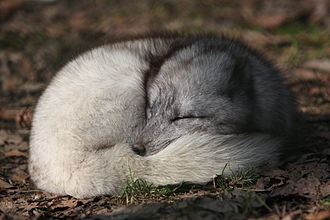
Arctic foxes must endure a temperature difference of up to 90–100 °C (160–180 °F) between the external environment and their internal core temperature. [14] To prevent heat loss, the Arctic fox curls up tightly tucking its legs and head under its body and behind its furry tail. This position gives the fox the smallest surface area to volume ratio and protects the least insulated areas. Arctic foxes also stay warm by getting out of the wind and residing in their dens. [15] [14] Although the Arctic foxes are active year-round and do not hibernate, they attempt to preserve fat by reducing their locomotor activity. [15] [16] They build up their fat reserves in the autumn, sometimes increasing their body weight by more than 50%. This provides greater insulation during the winter and a source of energy when food is scarce. [17]
Reproduction
In the spring, the Arctic fox’s attention switches to reproduction and a home for their potential offspring. They live in large dens in frost-free, slightly raised ground. These are complex systems of tunnels covering as much as 1,000 m 2 (11,000 sq ft) and are often in eskers, long ridges of sedimentary material deposited in formerly glaciated regions. These dens may be in existence for many decades and are used by many generations of foxes. [17]
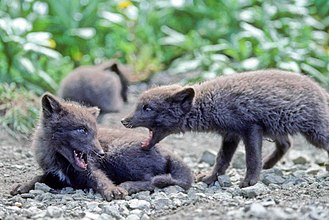
Arctic foxes tend to select dens that are easily accessible with many entrances, and that are clear from snow and ice making it easier to burrow in. The Arctic fox builds and chooses dens that face southward towards the sun, which makes the den warmer. Arctic foxes prefer large, maze-like dens for predator evasion and a quick escape especially when red foxes are in the area. Natal dens are typically found in rugged terrain, which may provide more protection for the pups. But, the parents will also relocate litters to nearby dens to avoid predators. When red foxes are not in the region, Arctic foxes will use dens that the red fox previously occupied. Shelter quality is more important to the Arctic fox than the proximity of spring prey to a den. [12]
The main prey in the tundra are lemmings, which is why the white fox is often called the “lemming fox”. The white fox’s reproduction rates reflect the lemming population density, which cyclically fluctuates every 3–5 years. [9] [13] When lemmings are abundant, the white fox can give birth to 18 pups, but they often do not reproduce when food is scarce. The “coastal fox” or blue fox lives in an environment where food availability is relatively consistent, and they will have up to 5 pups every year. [13]
Breeding usually takes place in April and May, and the gestation period is about 52 days. Litters may contain as many as 25 (the largest litter size in the order Carnivora). [18] The young emerge from the den when 3 to 4 weeks old and are weaned by 9 weeks of age. [17]
Arctic foxes are primarily monogamous and both parents will care for the offspring. When predators and prey are abundant, Arctic foxes are more likely to be promiscuous (exhibited in both males and females) and display more complex social structures. Larger packs of foxes consisting of breeding or non-breeding males or females can guard a single territory more proficiently to increase pup survival. When resources are scarce, competition increases and the number of foxes in a territory decreases. On the coasts of Svalbard, the frequency of complex social structures is larger than inland foxes that remain monogamous due to food availability. In Scandinavia, there are more complex social structures compared to other populations due to the presence of the red fox. Also, conservationists are supplying the declining population with supplemental food. One unique case, however, is Iceland where monogamy is the most prevalent. The older offspring (1-year-olds) often remain within their parent’s territory even though predators are absent and there are fewer resources, which may indicate kin selection in the fox. [13]
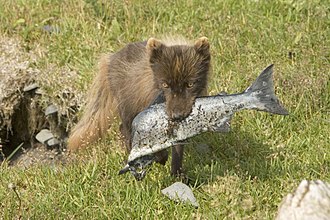
Arctic foxes generally eat any small animal they can find, including lemmings, voles, other rodents, hares, birds, eggs, fish, and carrion. They scavenge on carcasses left by larger predators such as wolves and polar bears, and in times of scarcity also eat their feces. In areas where they are present, lemmings are their most common prey, [17] and a family of foxes can eat dozens of lemmings each day. In some locations in northern Canada, a high seasonal abundance of migrating birds that breed in the area may provide an important food source. On the coast of Iceland and other islands, their diet consists predominantly of birds. During April and May, the Arctic fox also preys on ringed seal pups when the young animals are confined to a snow den and are relatively helpless. They also consume berries and seaweed, so they may be considered omnivores. [19] This fox is a significant bird-egg predator, consuming eggs of all except the largest tundra bird species. [20] When food is overabundant, the Arctic fox buries (caches) the surplus as a reserve.
Arctic foxes survive harsh winters and food scarcity by either hoarding food or storing body fat. Fat is deposited subcutaneously and viscerally in Arctic foxes. At the beginning of winter, the foxes have approximately 14740 kJ of energy storage from fat alone. Using the lowest BMR value measured in Arctic foxes, an average sized fox (3.5 kg (7.7 lb)) would need 471 kJ/day during the winter to survive. Arctic foxes can acquire goose eggs (from greater snow geese in Canada) at a rate of 2.7–7.3 eggs/h, and they store 80–97% of them. Scats provide evidence that they eat the eggs during the winter after caching. Isotope analysis shows that eggs can still be eaten after a year, and the metabolizable energy of a stored goose egg only decreases by 11% after 60 days (a fresh egg has about 816 kJ). Researchers have also noted that some eggs stored in the summer are accessed later the following spring prior to reproduction. [21]
Adaptations
The Arctic fox lives in some of the most frigid extremes on the planet, but they do not start to shiver until the temperature drops to −70 °C (−94 °F). Among its adaptations for survival in the cold is its dense, multilayered pelage, which provides excellent insulation. [22] [23] Additionally, the Arctic fox is the only canid whose foot pads are covered in fur. There are two genetically distinct coat color morphs: white and blue. [15] The white morph has seasonal camouflage, white in winter and brown along the back with light grey around the abdomen in summer. The blue morph is often a dark blue, brown, or grey color year-round. Although the blue allele is dominant over the white allele, 99% of the Arctic fox population is the white morph. [13] [9] Two similar mutations to MC1R cause the blue color and the lack of seasonal color change. [24] The fur of the Arctic fox provides the best insulation of any mammal. [25]
The fox has a low surface area to volume ratio, as evidenced by its generally compact body shape, short muzzle and legs, and short, thick ears. Since less of its surface area is exposed to the Arctic cold, less heat escapes from its body. [26]
Sensory modalities
The Arctic fox has a functional hearing range between 125 Hz–16 kHz with a sensitivity that is ≤ 60 dB in air, and an average peak sensitivity of 24 dB at 4 kHz. Overall, the Arctic foxes hearing is less sensitive than the dog and the kit fox. The Arctic fox and the kit fox have a low upper-frequency limit compared to the domestic dog and other carnivores. [27] The Arctic fox can easily hear lemmings burrowing under 4-5 inches of snow. [28] When it has located its prey, it pounces and punches through the snow to catch its prey. [26]
The Arctic fox also has a keen sense of smell. They can smell carcasses that are often left by polar bears anywhere from 10 to 40 km (6.2 to 24.9 mi). It is possible that they use their sense of smell to also track down polar bears. Additionally, Arctic foxes can smell and find frozen lemmings under 46–77 cm (18–30 in) of snow, and can detect a subnivean seal lair under 150 cm (59 in) of snow. [29]
Physiology
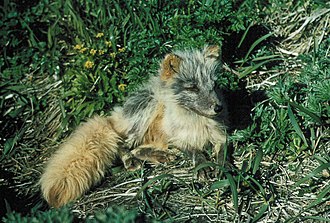
Arctic fox lying in grass. A fox’s thick winter coat helps keep its body temperature near 38 °C (100 °F). Foxes also have fur on the soles of their feet and reduced blood flow to their legs to help keep them warm.
The Arctic fox contains advantageous genes to overcome extreme cold and starvation periods. Transcriptome sequencing has identified two genes that are under positive selection: Glycolipid transfer protein domain containing 1 (GLTPD1) and V-akt murine thymoma viral oncogene homolog 2 (AKT2). GLTPD1 is involved in the fatty acid metabolism, while AKT2 pertains to the glucose metabolism and insulin signaling. [30]
The average mass specific BMR and total BMR are 37% and 27% lower in the winter than the summer. The Arctic fox decreases its BMR via metabolic depression in the winter to conserve fat storage and minimize energy requirements. According to the most recent data, the lower critical temperature of the Arctic fox is at −7 °C (19 °F) in the winter and 5 °C (41 °F) in the summer. It was commonly believed that the Arctic fox had a lower critical temperature below −40 °C (−40 °F). However, some scientists have concluded that this statistic is not accurate since it was never tested using the proper equipment. [14]
About 22% of the total body surface area of the Arctic fox dissipates heat readily compared to red foxes at 33%. The regions that have the greatest heat loss are the nose, ears, legs, and feet, which is useful in the summer for thermal heat regulation. Also, the Arctic fox has a beneficial mechanism in their nose for evaporative cooling like dogs, which keeps the brain cool during the summer and exercise. [16] The thermal conductivity of Arctic fox fur in the summer and winter is the same; however, the thermal conductance of the Arctic fox in the winter is lower than the summer since fur thickness increases by 140%. In the summer, the thermal conductance of the Arctic foxes body is 114% higher than the winter, but their body core temperature is constant year-round.
One way that Arctic foxes regulate their body temperature is by utilizing a countercurrent heat exchange in the blood of their legs. [14] Arctic foxes can constantly keep their feet above the tissue freezing point (−1 °C (30 °F)) when standing on cold substrates without losing mobility or feeling pain. They do this by increasing vasodilation and blood flow to a capillary rete in the pad surface, which is in direct contact with the snow rather than the entire foot. They selectively vasoconstrict blood vessels in the center of the foot pad, which conserves energy and minimizes heat loss. [16] [31] Arctic foxes maintain the temperature in their paws independently from the core temperature. If the core temperature drops, the pad of the foot will remain constantly above the tissue freezing point. [31]
The average head-and-body length of the male is 55 cm (22 in), with a range of 46 to 68 cm (18 to 27 in), while the female averages 52 cm (20 in) with a range of 41 to 55 cm (16 to 22 in). [22] [32] In some regions, no difference in size is seen between males and females. The tail is about 30 cm (12 in) long in both sexes. The height at the shoulder is 25 to 30 cm (9.8 to 11.8 in). [33] On average males weigh 3.5 kg (7.7 lb), with a range of 3.2 to 9.4 kg (7.1 to 20.7 lb), while females average 2.9 kg (6.4 lb), with a range of 1.4 to 3.2 kg (3.1 to 7.1 lb). [22]
Polar bear diet
Polar bears are the top predator in the Arctic marine ecosystem. The polar bear’s body requires a diet based on large amounts of seal fat, making it the most carnivorous member of the bear family.
Food can be hard to come by for polar bears for much of the year. The bear puts on most of its yearly fat reserves between late April and mid-July to maintain its weight in the lean seasons.
The food-free season can last 3 to 4 months — or even longer in areas like Canada’s Hudson Bay. As the Arctic warms due to climate change, the ice pack is forming later in the season, and bears must wait longer to begin hunting again.
Did you know?
Don’t move! The polar bear often relies on ”still hunting” — patiently waiting next to a hole in the ice until it senses a surfacing seal.
Hunting by smell. Using its sense of smell, the polar bear will locate seal birth lairs, and then break through the lair’s roof in order to catch its prey.
Learning to hunt. The adolescent polar bear often has to scavenge on the carcasses of other bears’ kills while learning to develop its own hunting skills.
Efficient digestion. The bear’s digestive system absorbs approximately 84% of the protein and 97% of the fat it consumes.
Fatty diet. The average polar bear can consume 2kg (4.4 lbs) of fat in a day.
A big appetite. The bear’s enormous stomach can hold 10-20% of its body weight.
What do Polar Bears Eat?
Polar bears are the largest bears globally and are the number one predator in the Arctic. Additionally, polar bears are the biggest land carnivores on the planet and are roughly 3.5 to 5 feet tall on all fours.
Adult male polar bears are larger than females, and when standing on their hind legs, they measure over 10 feet. That begs the question, what do polar bears eat to become such outsized land and sea predators?
Find Out About the Polar Bear Diet
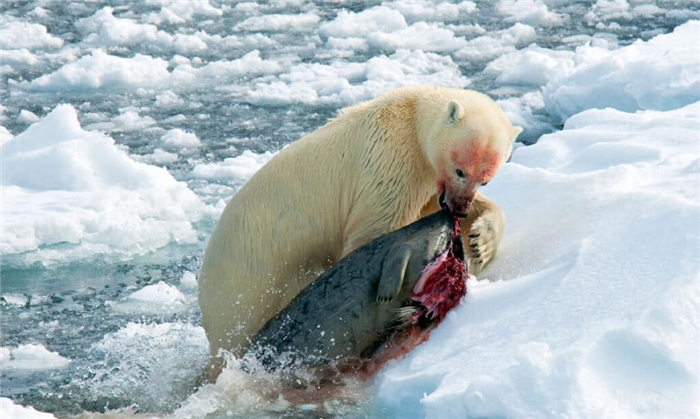
Polar bears eat a diet of ringed seals, bearded seals, carcasses, Narwhals, Beluga Whales, Walrus, Muskox, and many others.
Polar bears eat a diet that consists of seals, carcasses, and bigger marine prey to keep up their health in the harsh Arctic environment. They are predominantly meat-eaters but are known to be scavengers and will eat berries and seaweed if their food supply is low.
Seals are a high-energy food source and a favorite meal of many polar bears. Polar bears mainly eat ringed and bearded seals but may also gorge themselves on harp, hooded, and ribbon seals if nothing else is available.
If the seal weighs 120 pounds or more, this meal can provide the polar bear with up to eight days’ worth of energy. Although this may sound like an adequate meal, polar bears need to eat much more than a 120-pound seal to maintain their reserves.
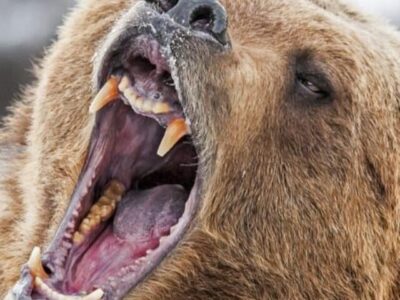
The 9 Best Books About Bears – Safety Tips and Species Insights Reviewed and Ranked
Complete List of Foods That Polar Bears Eat:
- Ringed seals
- Bearded seals
- Carcasses
- Reindeer
- Small rodents
- Waterfowl
- Shellfish
- Fish
- Eggs
- Kelp
- Berries
- Human garbage
Due to climate change, the Arctic ice is melting faster. This slow destruction of their habitat leaves polar bears less time to hunt seals and marine prey during the spring when they are supposed to stock up on their fat reserves.
Because of their dwindling habitat, polar bears have been finding alternative food sources to compensate for the loss of hunting time. Consequently, scientists have discovered that polar bears supplement their food sources by eating other polar bears when their food supplies run low. These animals have also started eating grass and marine algae more frequently to survive.
How Do Polar Bears Hunt?
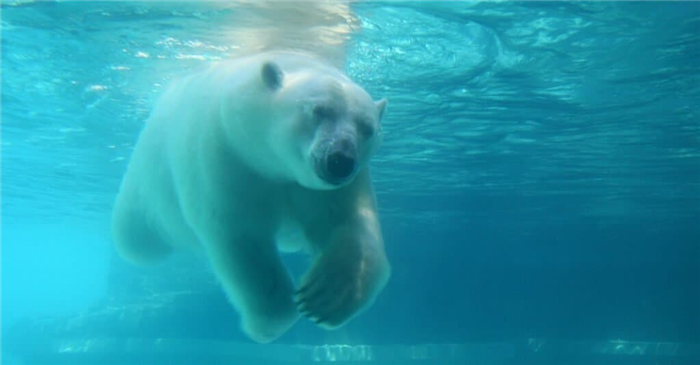
Polar bear swimming underwater. Polar bears can swim for long distances and steadily for many hours to get from one piece of ice to another, in between hunting their prey.
Most polar bears play the waiting game when hunting for prey, specifically seals. In the fall, seals cut breathing holes into the ice using their sharp claws. Polar bears wait patiently next to breathing holes and attack the seal when it comes up to breathe.
This hunting method may seem random and opportunistic, but polar bears are incredibly intentional hunters as they locate the seals with their powerful sense of smell. Waiting for seals to surface for air is then an easy way to catch their favorite food.
Female polar bears with pups are known to stalk the birthing lairs of seals. Ringed seals have shelters which are caves under snowdrifts next to a hole in the ice. They give birth to their pups in these lairs during the spring.
Polar bears wait outside these hollows and destroy the roof with their hind legs, exposing the seal and pups. Female polar bears with pups frequently use this hunting method as it takes less energy and provides them and their pups with the proper high-fat diet they need for healthy growth.
Do Polar Bears Hibernate?
Polar bears do not typically hibernate, but females enter a state of carnivore lethargy, which is a form of hibernation. Carnivore lethargy usually takes place from October/November until March/April. The female’s heart rate slows down to roughly 27 beats per minute during this period to conserve energy. Also, her body temperature can drop to 95°F, and she fasts during this time, resulting in losing most or all of her fat stores.
Polar bears can enter carnivore lethargy and survive long periods without food due to their fat stores. These marine mammals have a thick layer of fat that keeps them warm and acts as a reserve food source. Polar bears have substantial appetites and can eat 100 pounds of seal blubber in one feed. If food is plentiful, they may sometimes only eat the seal fat.
Who Competes With Polar Bears for Food?
Due to climate change, there has been a decrease in ice during the summer season. When this happens, polar bears often eat marine mammal carcasses to make up for a loss of their food sources. For example, in Alaska, polar bears eat bowhead whale carcasses that have been subsistence-harvested.
But if polar bears do not have this option, they have to move onto the land to pursue other large prey and birds during the summer/fall open-water period. Polar bears then compete with grizzly bears for food.
What Do Polar Bear Cubs Eat?
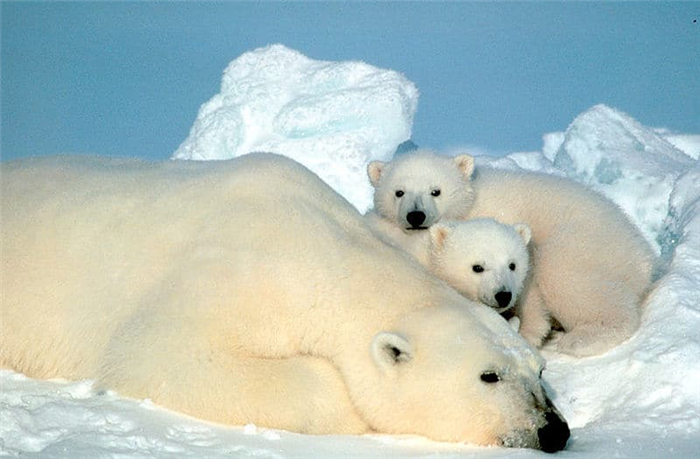
Polar Bear cubs drink mother’s milk up to four months.
U.S. Fish and Wildlife Service – Public Domain
Polar bear cubs drink their mother’s milk, which is rich in fat, for the first three to four months. Their first solid meal is generally around three to four months when their mother hunts on the open ice for the first time since giving birth. Polar bear cubs then eat portions of meat and seal blubber to supplement their diets.
The polar bear cubs learn to hunt by observing their mother and usually start trying to stalk their prey in their first year. Their first few hunts are typically unsuccessful, but they become better with practice. When polar bear cubs are two years old, they spend 7% of their time hunting and can catch a seal roughly once a week.
Are Polar Bears Dangerous to Humans?
Although polar bears are frighteningly massive, they are not as threatening to people as you might think. Because their habitat is not typically close to that of humans, polar bear attacks are very rare. The Wildlife Society Bulletin found only 73 confirmed attacks between 1870 and 2014, showing that they are a low-level risk to us.
However, attacks from polar bears have been rising, with hungry male bears often being the instigators. Due to climate change, a decrease in habitat size, and food supply, polar bear attacks on humans have risen. Fortunately, these invasions into human territory and aggression are still sporadic.
What do polar bears eat?
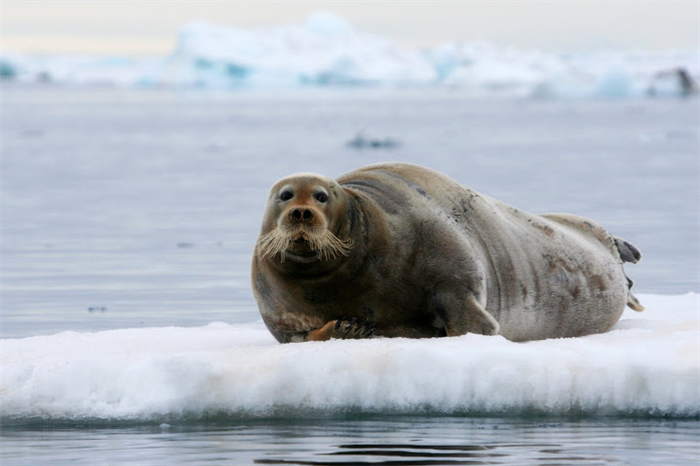
Photo credit: Morten Ekker Polar bears are the most carnivorous of all the bear species. They metabolize fat more efficiently than protein, and their energy-rich diet enables them to have a larger body size than other bears. Polar bears feed primarily on ringed seals, but will also eat bearded seals, harp seals, hooded and harbor seals, when available.
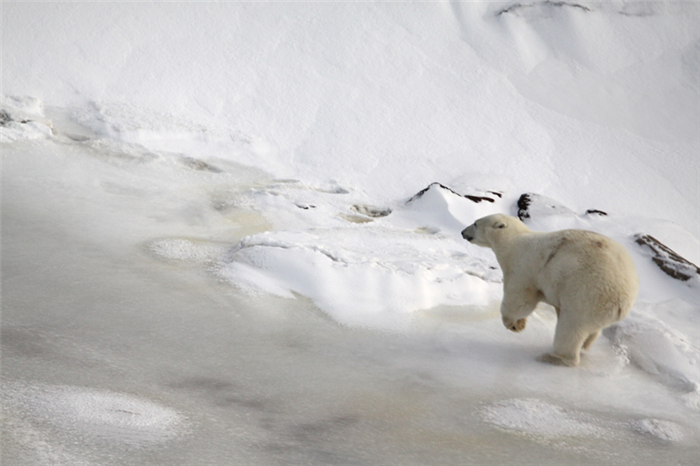
Larger prey species such as walrus, narwhal and beluga are occasionally hunted. Polar bears will readily scavenge on marine mammal carcasses. Polar bears will also eat birds, fish, vegetation and kelp, although the caloric contribution of such foods likely contributes little to their overall sustenance. Photo credit: U.S. Fish and Wildlife Servic Bears that remain on land during the summer months rely primarily on their fat reserves and conserve their energy by remaining inactive most of the time.
Polar Bear Biology
Photo credit: Morten Ekker
Photo credit: U.S. Fish and Wildlife Service
Reproduction
Photo credit: Kristin Laidre
Photo credit: Kristin Laidre
Polar Bear
Polar bears are the largest carnivorous land mammals on Earth. They are about seven to eight feet long, measured from the nose to the tip of their very short tail. Male polar bears are much larger than the females. A large male can weigh more than 1,700 pounds, while a large female is about half that size (up to 1,000 pounds). Bears can weigh about 50 percent more after a successful hunting season than they do at the start of the next; most of this additional weight is accumulated fat. A newborn polar bear weighs only about 1.5 pounds.
Many of the polar bear’s physical adaptations help it maintain body heat and deal with its icy habitat. The bear’s outer layer of fur is hollow and reflects light, giving the fur a white color that helps the bear remain camouflaged. The skin under the polar bear’s fur is actually black; this black is evident only on the nose. Polar bears also have a thick layer of fat below the surface of the skin, which acts as insulation on the body to trap heat. This is especially important while swimming and during the frigid Arctic winter. The bear’s large size reduces the amount of surface area that’s exposed to the cold per unit of body mass (pounds of flesh), which generates heat.
The polar bear’s footpads have a kind of “non-slip” surface, allowing them to get traction on slippery ice. Polar bears have strong legs and large, flattened feet with some webbing between their toes, which helps with swimming and walking on ice. The wide paws prevent sea ice from breaking by distributing the polar bear’s weight as it walks. The webbed feet results in making polar bears, unlike other bear species, considered to be “marine mammals” along with seals, sea lions, walruses, whales, and dolphins. However, they are still bears. The polar bear evolved one to three million years ago from the brown bear, which still ekes out a marginal life along the northern shore of the Arctic oceans. Unlike the massive polar bear, which can grow huge on a diet of abundant seals, its ancestor in the Arctic is small, has very lower reproductive rates, and eagerly eats almost anything that exists in its environment.
Polar bears have evolved something else that is different from their ancestor: most polar bears don’t den, however all brown bears do. When grizzly bear food is covered in snow during the winter, this species must den because there is nothing to eat. In contrast, most polar bears have access to their food of choice (seals) all winter long, so there is no need for them to den. The exception to this is pregnant adult females. Pregnant female polar bears must den so that their tiny newborn cubs are born in a warm protected environment; dens can be 38 degrees Fahrenheit warmer than the outside temperature. The cubs would otherwise freeze to death in the frigid temperatures of the far north.
Most polar bears occur north of the Arctic Circle to the North Pole. There are some populations south of the Arctic Circle in the Hudson Bay of Manitoba, Canada. Polar bears live in Alaska, Canada, Russia, Greenland, and some northern islands owned by Norway, such as Svalbard.
Polar bears depend on the sea ice, which forms above the open waters where their seal prey lives. They will spend time on land when sea ice is not available (and most pregnant polar bear females make their dens on shore near the coast). Polar bears are excellent swimmers, and they travel long distances between shore and the sea ice if necessary. However, if a storm kicks up during these increasingly long swims (caused by the warming ocean), they can drown. These long swims and storms are also often difficult for cubs. During periods of ice breakup, polar bears frequently swim between floating ice islands.
Permanent, multi-year ice that doesn’t ever melt is more important to polar bears than the annual ice that melts and reforms every year; this multi-year ice is increasingly rare, but will likely persist for longer in the island archipelago of northwestern Canada than in Alaska or off the northern coast of Russia.
Unlike other bear species, polar bears are almost exclusively meat eaters (carnivorous). They mainly eat ringed seals, but may also eat bearded seals. Polar bears hunt seals by waiting for them to come to the surface of sea ice to breathe. When the seal nears the surface, the polar bear will bite or grab the seal and pull it onto land to feed. They also eat walruses and whale carcasses. Polar bears will search out bird eggs and other food sources, but none of these are abundant enough to sustain the large body mass and dense populations of polar bears.
Another vitally important food source in most areas are seal pups that are born and live in dens in the Arctic ice. The polar bear identifies these dens by smell and other markers and pounces though the roof of the den to capture the young seals. In Hudson Bay, the availability of seal pups in the spring is increasingly limited by earlier melting of ice. In the Arctic, polar bears are at the top of the food chain; they eat everything and nothing (except native hunters) eats them.
Polar bears tend to live solitary lives except when mating, when a female raising her cubs forms a family group, or when many bears are attracted to a food source like a beached whale. Young polar bears spending the summer ashore on the Hudson Bay coast will frequently play with each other, most commonly with their siblings. Polar bears near Churchill on the coast of Hudson Bay are even known to play with chained sled dogs without killing them, which they could easily do.
Polar bears breed in the late spring as the temperatures begin to rise in the Arctic. Like other bear species, however, they don’t really become pregnant at the time of breeding as the tiny embryo (or blastocyst) will not implant in the female’s uterus until fall, when true gestation starts. This is called delayed implantation and allows a female bear to physiologically assess her condition prior to starting gestation and the process of birthing, nursing, and carrying for her offspring for the next three years. The period of actual gestation following implantation is only about 60 days.
In the Hudson Bay population, where the reproductive biology of polar bears has been most extensively studied, it appears that a polar bear female carrying a blastocyst must achieve a body weight of at least 490 pounds to have the blastocyst implant and start gestation. If this threshold is not achieved, the blastocyst will reabsorb, the female will continue to hunt seals all winter, attempting to be fatter a year later and able to carry off a successful pregnancy.
In the beginning of the winter, a pregnant female will dig a den in a snow bank and begin the process of gestation. Depending on the area, pregnant females may enter dens anytime between early October and December. The time of exit from dens occurs between late February and April. Most females dig their dens in a snow bank on land, but some also den on the floating sea ice. In Hudson Bay, females may dig a den in the ground instead, but they use areas where the snow will build up and provide insulation. In the middle of winter in some of the coldest places on Earth, female polar bears give birth to cubs. Litter size is most commonly two cubs, but sometimes litters can be one, three, or, very rarely, four cubs.
Female polar bears in the Hudson Bay area spend remarkable periods of time fasting, the longest known of any mammal species. This fasting period before denning and in dens averages about 180 to 186 days. In Hudson Bay, pregnant females can successfully fast for as long as 240 days. The long period of fasting makes this species especially vulnerable to environmental changes like a warming climate, which reduces the amount of time they have available to build up the fat reserves they need to survive fasting and bring off a successful pregnancy.
When the cubs are born, they are completely dependent on their mother. They stay in the den nursing on her rich milk until spring, when they emerge and start exploring the world as their mother heads out to the ice to catch the seals she needs to replenish the weight she’s lost during her period of fasting. Over the next two years, the cubs will learn from their mother how to catch seals themselves and to develop the other skills needed to survive and grow to adult size. Typically cubs will stay with their mother until they are two-and-a-half years old, but in some cases they will stay for a year more or a year less. If the mother is able to replenish her fat reserves sufficiently, she can produce a litter of cubs that survive until weaning every three years. When food declines in abundance, there is a longer period between successive successful litters, and litter sizes are smaller. Polar bears in the wild can live to be 30 years of age, but this is rare. Most adults die before they reach 25 years.
The conditions developing in Hudson Bay are such that females will no longer be able to birth and successfully raise a little of cubs. When this happens, the adult bears will survive until they die of old age and the population will be doomed. Scientists are fearful that this pattern is also starting to happen in the more northern polar bear populations as the amount of Arctic ice continues to shrink.
Polar bears are in serious danger of going extinct due to climate change. In 2008, the polar bear became the first vertebrate species to be listed under the U.S. Endangered Species Act as threatened due to predicted climate change. The Secretary of Interior listed the polar bear as threatened but restricted the Endangered Species Act’s protections, and thus the polar bear’s future is still very much in jeopardy.
The chief threat to the polar bear is the loss of its sea ice habitat due to climate change. As suggested by its specific scientific name (Ursus maritimus), the polar bear is actually a marine mammal that spends far more time at sea than it does on land. It’s on the Arctic ice that the polar bear makes its living, which is why climate change is such a serious threat to its well-being. Polar bears are being impacted by climate change in several ways.
Population sizes are decreasing: In southern portions of their range around Hudson Bay, Canada, there is no sea ice during the summer, and the polar bears must live on land until the bay freezes in the fall, when they can again hunt on the ice. While on land during the summer, these bears eat little or nothing. In just 20 years, the ice-free period in Hudson Bay has increased by an average of 20 days, cutting short polar bears’ seal hunting season by nearly three weeks. The ice is freezing later in the fall, but it is the earlier spring ice melt that is especially difficult for the bears. They have a narrower time frame in which to hunt during the critical season when seal pups are born, and average bear weight has dropped by 15 percent. The bears have fewer cubs, and of the cubs they do have, the frequency of survival to adulthood is decreasing. In addition, the interval between successful litters is growing. As a result, the Hudson Bay population is down more than 20 percent. The patterns seen in Hudson Bay are beginning to occur now in more northern populations and is especially well documented on the north coast of Alaska, but appears to be the case worldwide.
Sea ice platforms are moving farther apart: The retreat of ice has implications beyond the obvious habitat loss. Remaining ice is farther from shore, making it less accessible. After each summer, the trend seen in the Arctic is for sea ice to be farther from shore, making it necessary for polar bears to swim increasingly long distances from shore to reach the ice. Worse, the last remaining sea ice is over deep and unproductive waters that yield less prey. The larger gap of open water between the ice and land also contributes to rougher wave conditions, making the bears’ swim from shore to sea ice more hazardous. In 2004, biologists discovered four drowned polar bears in the Beaufort Sea. Never before observed, biologists attributed the drowning to a combination of retreating ice and rougher seas. As a result of rapid ice melt in 2011, a female polar bear reportedly swam for nine days nonstop across the Beaufort Sea before reaching an ice floe, costing her 22 percent of her weight and her cub. As climate change melts sea ice, the U.S. Geological Survey projects that two thirds of polar bears will disappear by 2050.
Food scarcity is increasing: As sea ice disappears for longer and longer periods during the late summer, polar bears are left with insufficient time to hunt. Polar bears can only survive in areas where the oceans freeze, allowing them to hunt seals living under, on, or in the frozen polar ice cap. Exacerbating the problems of the loss of hunting areas, it is expected that the shrinking polar ice cap will also cause a decline in polar bears’ favorite prey—seals. The reduction in ice platforms near productive areas for the fish eaten by seals is affecting the seals’ nutritional status and reproduction rates. Polar bears are going hungry for longer periods of time, resulting in cannibalistic behavior. Although it has long been known polar bears will kill for dominance or kill cubs so they can breed with the female, outright predation for food was previously unobserved by biologists.
Additionally, development is increasing in ocean floor exploration and offshore oil extraction in the open waters that were previously sealed by frozen ice. This brings people, disturbance, and potentially ruinous oil spills to the previously pristine Arctic polar bear habitat. Polar bears need our help and protection to ensure a long, healthy future for the species. The best way for people to help polar bears is by reducing carbon emissions and working with the National Wildlife Federation to campaign for reductions in climate change pollutants.
1. Because they spend so much time in the ocean, polar bears are classified as marine mammals. The polar bear’s scientific name, Ursus maritimus, means “sea bear.”
2. Polar bears evolved from brown bears to survive in extreme northern environments.
3. Polar bears are the largest terrestrial predator on the planet, with large males standing more than 11 feet (3.3 meters) tall on their hind legs and reaching weights over 1,700 pounds (770 kilograms).
4. Unlike black bears and brown bears, polar bears do not hibernate during the winter months because that’s when sea ice forms, which the polar bears need to hunt seals.
5. When necessary or playing, polar bears communicate with each other with grunts, growls, roars, or squeals. What does a polar bear roar sound like? We hit the streets to pose this simple question. Hear what people had to say:
